Introduction
Windows Virtual PC is a downloadable add-on to Windows 7 Professional, Ultimate, or Enterprise that allows you to run a Windows XP environments from within Windows 7. Windows XP Mode, which requires Windows Virtual PC, is a prepackaged fully activated copy of Windows XP Professional with Service Pack 3 installed. With both of these programs installed, you can then run Windows XP in Windows 7 so that you can continue to use programs that were developed for Windows XP but no longer run in Windows 7.
In order to use the Virtual PC technology your computer's CPU must have hardware virtualization support and it this hardware virtualization must be enabled. For Intel processors this support is called Intel Virtualization Technology and for AMD processors it is called AMD-V. To determine if your processor has hardware virtualization please consult the following section.
Also when reading this tutorial you will find that I use the word host often. This terms refers to the Windows 7 operating system that the Windows XP Mode installation is running upon.
How to determine if the processor supports hardware virtualization
If you have an Intel Processor then you need to do the following to determine if your processor has hardware virtualization:
First, download and install the Intel Processor Identification Utility and run it one your computer. Once the program is installed launch the program. It can be found under the Start Menu -> All Programs -> Intel(R) Processor ID Utility. Once launched you will need to accept the license agreement and then you will be at a screen similar to the following image:
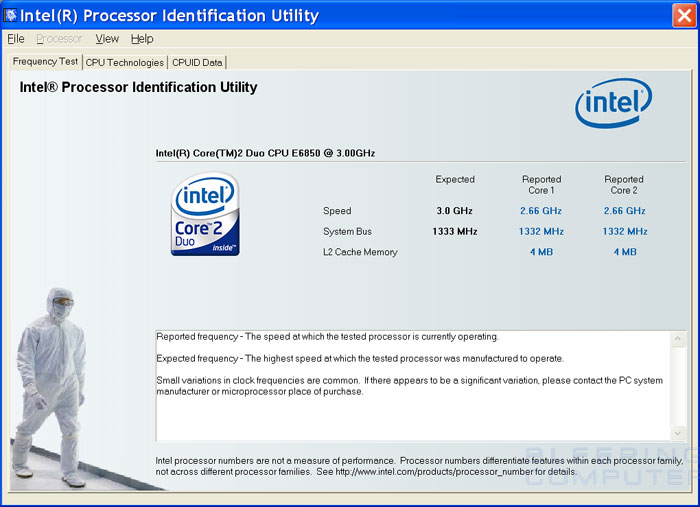
Intel Processor Identification Utility
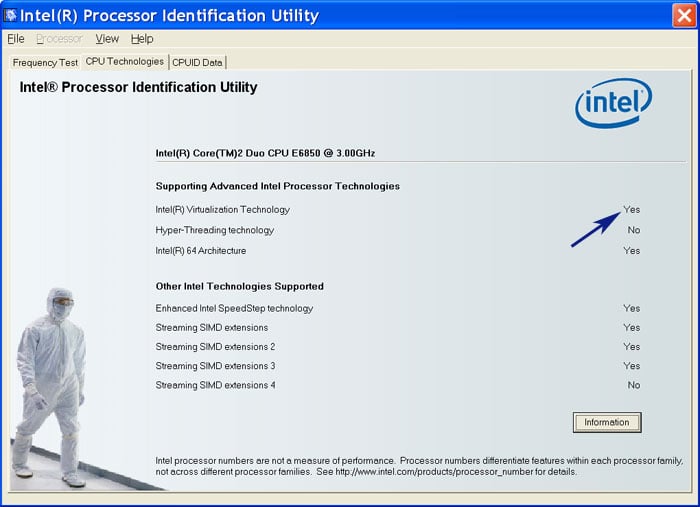
CPU Technologies Screen
 Now that Virtualization is enabled on your computer, we need to
download Windows Virtual PC and Windows XP Mode. To do this, visit the Windows Virtual PC Download
page. Once there, scroll down till you see Step 1 and select the type
of Windows 7 installed and your language. Then click on the Download Windows Virtual PC RC and the Windows XP Mode RC buttons to download each file.
Now that Virtualization is enabled on your computer, we need to
download Windows Virtual PC and Windows XP Mode. To do this, visit the Windows Virtual PC Download
page. Once there, scroll down till you see Step 1 and select the type
of Windows 7 installed and your language. Then click on the Download Windows Virtual PC RC and the Windows XP Mode RC buttons to download each file.
Once the files are downloaded, you should install the Windows Virtual PC Beta first. This file is the smaller of the two, currently at 6.64 MB, is named Windows6.1-KB958559-x86.msu for 32 bit Windows or Windows6.1-KB958559-x64.msu for 64 bit Windows. When you double-click on the file, it will scan your computer for a certain update, and if not found, will prompt you to download the KB958559 update as shown below.
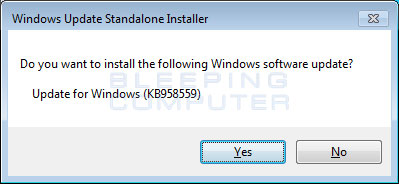
Install the KB958559 Windows 7 update
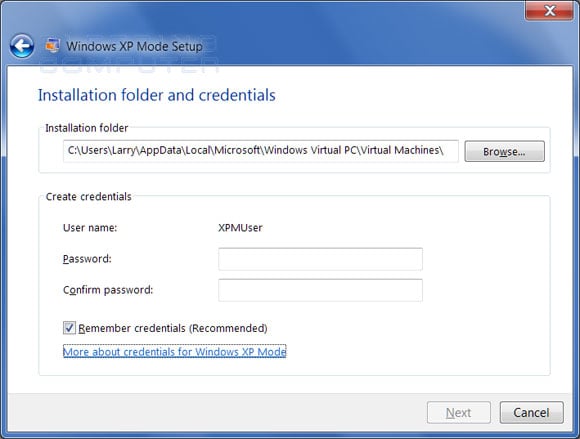
XP Mode Credentials
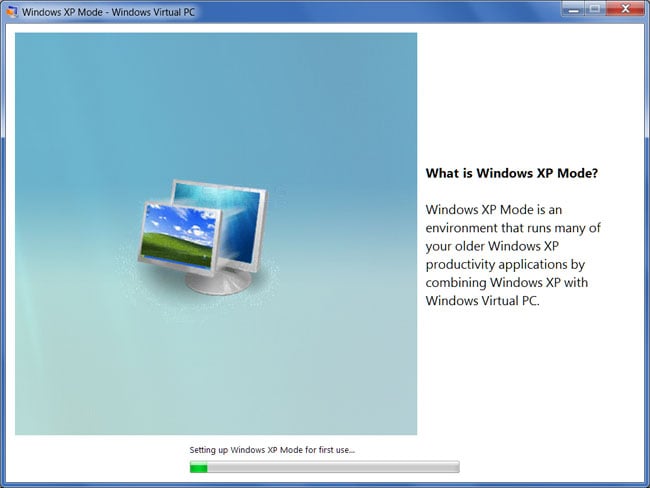
Windows XP Mode being setup for its first use
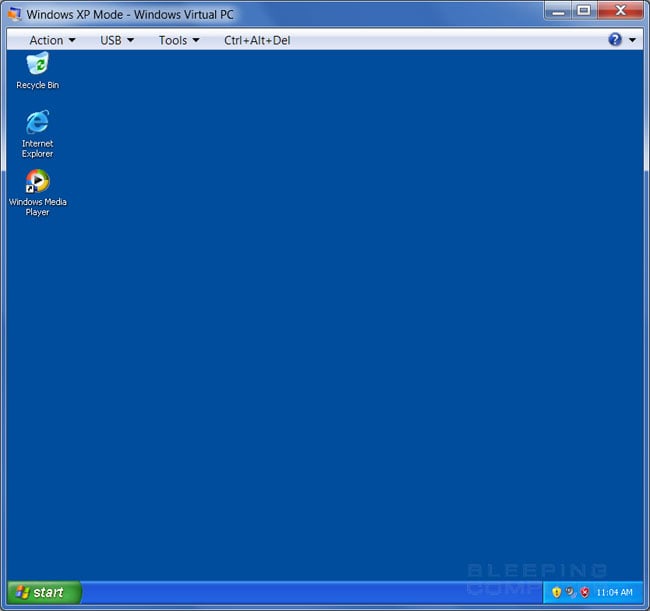
Windows XP Mode Desktop
source
Windows Virtual PC is a downloadable add-on to Windows 7 Professional, Ultimate, or Enterprise that allows you to run a Windows XP environments from within Windows 7. Windows XP Mode, which requires Windows Virtual PC, is a prepackaged fully activated copy of Windows XP Professional with Service Pack 3 installed. With both of these programs installed, you can then run Windows XP in Windows 7 so that you can continue to use programs that were developed for Windows XP but no longer run in Windows 7.
In order to use the Virtual PC technology your computer's CPU must have hardware virtualization support and it this hardware virtualization must be enabled. For Intel processors this support is called Intel Virtualization Technology and for AMD processors it is called AMD-V. To determine if your processor has hardware virtualization please consult the following section.
Also when reading this tutorial you will find that I use the word host often. This terms refers to the Windows 7 operating system that the Windows XP Mode installation is running upon.
How to determine if the processor supports hardware virtualization
If you have an Intel Processor then you need to do the following to determine if your processor has hardware virtualization:
First, download and install the Intel Processor Identification Utility and run it one your computer. Once the program is installed launch the program. It can be found under the Start Menu -> All Programs -> Intel(R) Processor ID Utility. Once launched you will need to accept the license agreement and then you will be at a screen similar to the following image:

Intel Processor Identification Utility
You should now click on the CPU Technologies tab and you will see a screen as shown below.

CPU Technologies Screen
On this screen, look for the row labeled Intel(R) Virtualization Technology, as shown by the arrow in the image above. If it states Yes, then you can use Virtual PC and Windows XP Mode in Windows 7, and should continue to the section where we learn how to install it.
If it does not say Yes, then you will not be able to use Windows XP
Mode on your computer. You can now close the Intel Processor
Identification Utility.
If you have an AMD Processor then you need to do the following to determine if your processor has hardware virtualization:
If you have an AMD processor then you will need to download the AMD Virtualization Technology and Microsoft Hyper-V System Compatibility Check Utility.
Once downloaded, extract the files and navigate to the folder where the
files are extracted. In order to run the utility in Windows 7, you will
need to run it with elevated privileges. To do this, right-click on the
amdvhyperv.exe file and select Run as administrator. When the program loads it will tell you whether or not your AMD processor supports Hyper-V as shown below.

If it does not support Hyper-V, then you will not be able to use Windows XP Mode in Windows 7.
If the above tests state that your processor does not support hardware
virtualization, it may be you need to enable this feature your
motherboard's BIOS. As motherboards have different methods of entering
the bios and configuring it, giving you step-by-step instructions is
impossible. Typically, though, to enter your bios you will boot your
computer and then look for a prompt asking if you would like to enter
setup or configure your bios and then stating what key you need to press
on your computer in order to do so. Typically these keys are F1, F2, DELETE, F10, F11, or F12.
I suggest that you turn off computer and then start it up before
attempting to access the BIOS, as otherwise the screen may not always
show. On certain machines, you may also see a computer or motherboard
brand logo that makes it so you cannot see the prompt to enter the BIOS.
If you see a large logo covering the screen, simply press the ESC key on your keyboard in order to see your BIOS setup instructions.
Once in the BIOS, you will need to search for virtualization settings
and make sure they are enabled. As each brand or manufacturer of
computers and motherboards, or even models of the same brand, may have
different locations as to where this setting is located in the BIOS, you
will need to search through the settings till you find it. Look for the
settings for Virtualization, AMD-V, or Virtual Machine and make sure it
is enabled. Once this is done, you can try the above tests again, and
if they now say you support virtualization you can continue with the
rest of the tutorial.
Once the files are downloaded, you should install the Windows Virtual PC Beta first. This file is the smaller of the two, currently at 6.64 MB, is named Windows6.1-KB958559-x86.msu for 32 bit Windows or Windows6.1-KB958559-x64.msu for 64 bit Windows. When you double-click on the file, it will scan your computer for a certain update, and if not found, will prompt you to download the KB958559 update as shown below.

Install the KB958559 Windows 7 update
You should click on the Yes key to allow this update
to be installed. When the update has finished installing, you will be at
the license screen. Click on the I accept button to
finish the installation of the program. When it has finished installing,
it will prompt you to reboot your computer. Please allow it to do so.
When you are back at your desktop, you should now double-click on the Windows XP Mode Beta installation file, which is named WindowsXPMode_en-us.exe.
When the installation program opens, follow the prompt to install the
program onto your computer. The installation may take a while as the
package is over 400MB, so please be patient. While installing, Windows
will display a User Account Control prompt asking if you wish to have
this software installed on the computer. At this prompt, click on the Yes button to continue. After the Windows XP Mode software has been installed, press the Finish
button and Windows XP Mode will start. Please continue to the next
section to learn how to configure Windows XP Mode when it runs for the
first time.
When you start Windows XP Mode for the first you will need to first accept the license agreement and then press the Next
button. You will now be at a screen, as shown below, where you are
asked to input the password for the user that XP Mode programs will run
under.

XP Mode Credentials
Create a password and enter it into the two password fields. If you do
not want to enter the password every time you start Windows XP Mode,
then put a checkmark in the Remember credentials checkbox. When done, click on the Next button.
You will now be asked if you would like to enable Automatic Updates. You should put a checkmark in the Help protect my computer by turning on Automatic Updates and then click on the Start Setup button. Windows Virtual PC will now setup Windows XP Mode for its first time use. This may take a while, so please be patient.

Windows XP Mode being setup for its first use
When the setup has been completed you will now be in Windows XP Mode
and will be presented with a Windows XP Professional desktop.

Windows XP Mode Desktop
While Windows XP Mode is running, the Virtual PC program will
automatically integrate all of your host computer's resources into
Windows XP Mode so that you can use them. This includes your your
computer's DVD/CD drives, hard drives, sound card, printers, and USB
devices.
To close Windows XP Mode you can click on the Actions menu and select Close
to hibernate your session and close the window. If you would like to
actually shutdown the Windows XP Mode, you need to click on the Ctrl+Alt+Del menu and then click on the Shut down button on the screen that pops up.
To star Windows XP Mode again you simply click on the Start Menu, select All Programs, scroll down to Windows Virtual PC, and then select Windows XP Mode.
To install applications in Windows XP Mode, you would install them like
they usually do. You can either download the programs over the network
or the web and install them directly from the Windows XP Mode hard
drives or you can install them via your host's shared resources like the
CD/DVD drives attached to your host computer. The only difference is
that the applications will be running in a virtual Windows XP
environment and therefore will run even if they are not compatible with
Windows 7. This will allow you to install any legacy applications that
you need to continue to have available.
A feature of Windows XP Mode is that any application you install that
uses Windows Installer will also have a shortcut automatically added to
the a Windows XP Mode Applications folder in your Windows 7 Start Menu.
If the program you install does not appear in the host's Windows XP Mode
Applications folder, you can manually make a shortcut appear by
creating a shortcut to the program in the C:\documents and settings\All Users\Start Menu\Programs
folder on your Windows XP Mode installation. You then need to log off
in Windows XP Mode and the program will now appear in the Windows XP
Mode Applications folder on your host computer.
When you launch these programs from the Start Menu, they will appear as
a normal program running on your computer rather than one running in a
virtual desktop. In fact, when you launch one of these applications you
will never see the Windows XP Mode desktop and the application will be
running directly on your normal desktop. To launch Windows XP Mode
applications you would need to navigate via the Start Menu to All Programs, scroll down to Windows Virtual PC, and then Windows XP Mode Applications. Under that sub folder you will see a list of applications that you can directly launch from within Windows 7.
When running XP Mode Applications directly from the desktop, it is
important to understand that Windows XP Mode is started, but is being
run behind the scenes so that the actual desktop is hidden. The running
XP Mode Applications, though, still use the data and drives that are
normally on the Windows XP Mode desktop. That means any XP Mode programs
will be opening the XP Mode drives, and not the local drives of your
host Windows 7 operating system unless they are shared.
When you are done running an XP Mode application, you simply close it
like normal. This will put the Windows XP Mode virtual pc into a
hibernating state.
It is also important to note that when starting XP Mode applications,
they will start much faster if XP Mode is a hibernating state rather
than shutdown. Therefore, if you routinely use XP Mode applications, I
suggest you do not shut down your XP Mode when not using it and instead
leave it hibernating.
When running XP Mode it is possible to change the hardware and data
that is automatically integrated into the virtual pc. To change these
settings, when in the XP Mode desktop click on the Tools menu and then select Settings.... You will now be at the virtual pc settings screen and should click on the Integration Features
category. From here you can specify what hardware and features you
would like to integrate, or share, with your XP Mode desktop.
These features are:
- Audio - This should remain unchecked so that you have better performance. It should be noted that even with this unchecked, any sound from the XP Mode desktop will still play through your host's audio card.
- Clipboard - If this is enabled then you will be able to copy and paste between XP Mode and your normal desktop.
- Printer - Shares your host's printer with XP Mode.
- Smart Cards - Allows XP Mode to access the host's smart cards.
- Drives - Allows XP Mode to access the host's drives, which include hard drives, CD/DVD drives, and removable media.
Any changes you make to the settings above will be persistent each time
you start XP Mode. On the other hand, if you need to disable the
integration for a particular session you can click on the Tools menu and then select Disable Integration Features.
This will make it so that you do not have access to any of the host's
resources. To enable access to these resources, simply click on the Enable Integration Features option in the Tools menu.
If you find that XP Mode is not running as fast as you would like, or
you want to add more features, you need to tweak some settings in your
Virtual PC settings for XP Mode. In order to change these settings you
must first shut down XP Mode so that it is not in a hibernating state.
To do this, click on the Ctrl+Alt+Del menu and then click the Shut down button on the screen that pops up.
When XP Mode has shut down, click on the Start Menu, select All Programs, scroll down to Windows Virtual PC, and then select the Windows Virtual PC icon. You should now see a list of your Virtual PCs, including Windows XP Mode. Right-click on Windows XP Mode and then select Settings. Now that Windows XP Mode is shut down, you can change the settings for your virtual machine.
Settings that you may want to consider changing to increase performance and reliability are:
- Memory - If you find that your applications are running slowly, then you may want to bump this up so that your applications have access to more system memory.
- Hard Disks - You are able to add 2 more hard disks to your Windows XP Mode. So if you need to add another drive to your Windows XP Mode, you can do so here. This will allow you to create a second disk on another physical drive in your computer to enhance performance.
- Undo Disks - Undo disks allow you to create a base image of your Windows XP Mode installation and then save all changes into an undo disk. Then if you ever need to start over from your base image, you just go back into settings and discard the changes in your undo disk. The next time you start Windows XP Mode, you will be back at the base setup with all of the changes you have made discarded. I suggest that everyone turn this option on as it only increases the safety of your Windows XP Mode installation.
source
No comments:
Post a Comment